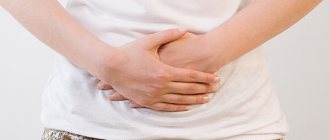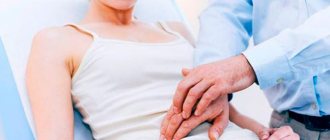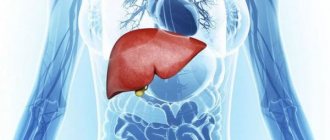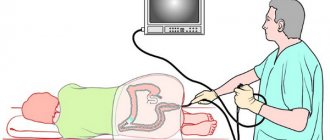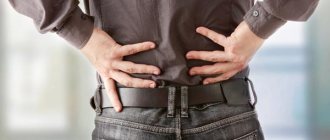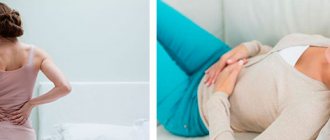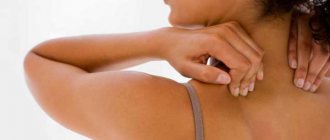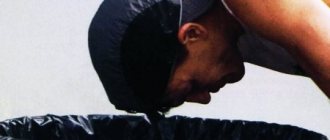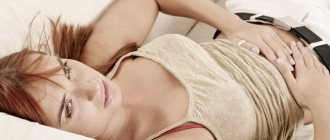Main reasons
The causes of girdle pain can affect different areas: the gastrointestinal tract, spine, internal organs, gynecological diseases. In some cases, symptoms are caused by other factors. For example, taking certain medications (Aspirin, Ibuprofen, Naproxen), antibiotics, laxatives, and during severe physical exertion.
From the gastrointestinal tract
One of the main diseases is small intestinal ulcer . Pathology appears due to increased acidity and gastritis. Factors that provoke ulcers include rough food, bad habits, hereditary predisposition, and taking non-steroidal drugs. Girdle pain occurs mainly after eating in the upper abdomen and spreads in a circular manner.
Perforation of the gastric walls is accompanied by pain in the navel area. Then the pain spreads throughout the abdomen and is stronger in the left side. There is no nausea, but severe pallor and rapid breathing appear. Negative sensations radiate to the back.
Gastroduodenitis, gastritis . The disease is characterized by acute girdle pain, and in chronic pathology, symptoms occur periodically and intensify with exacerbation. In this case, the sensations begin to diverge in a straight line - through the stomach, and then radiate to the left region of the back.
In internal organs
The most common cause of girdle pain is appendicitis . In this case, the symptoms arise in the navel area, then radiate down the abdomen, spread to the right side and become encircling and gradually gain strength. Other diseases of internal organs:
- Pancreatitis . This is an inflammation of the pancreas. The pain (often burning) spreads to the stomach and back, more severely to the right side. May radiate to the heart. Symptoms worsen at night.
- Thrombophlebic splenomegaly .
- Hepatic colic appears against the background of the formation of stones in the kidneys. As a result, a strong pain appears in the right side. Then it “spreads” through the stomach and back, affecting the shoulder blades, neck and shoulders.
- pyelonephritis is accompanied by nagging or cutting pain, which appears in the form of attacks. The same symptoms appear when urinating. Similar symptoms may occur with other renal diseases, as well as with hemorrhagic vasculitis.
- Diseases of the gallbladder, mainly cholecystitis . The symptoms are similar to hepatic colic, differing only in the manifestations. It starts on the right side of the back, then spreads under the ribs and then to the stomach. Can be handed over. When tapping or pressing, the pain is felt all over the back, intensifies during inhalations, when bending, raising the right leg, and radiates to the lower back.
- Pneumonia may also be accompanied by girdling pain. Moreover, it can radiate down the abdomen and move to the back area. Symptoms differ from gastrointestinal pathologies by their absence during movement.
- Damage to the walls of the abdominal cavity, its inflammation, that is, peritonitis .
Malignant tumors can appear in any organ and affect nearby ones. In this case, a strong aching girdle pain appears. It is also characteristic of the process of metastasis.
Heart problems
Girdle pain occurs with heart disease. For example, during a heart attack, it envelops the body completely, but is more clearly manifested on the left in the chest, arm, ribs, shoulder blade and neck. Cardiovascular diseases accompanied by circulatory disorders may also be the cause.
The symptoms can be confused with other diseases, but if you do not call an ambulance, death can occur.
Spine pathologies
Girdle pain often accompanies diseases of the spine. All its departments are associated with specific bodies. Therefore, having arisen in one place, the symptoms begin to spread to others. With osteochondrosis, the pain is acute and occurs when turning, moving, or lifting heavy objects.
Other pathologies of the spine include neuropathies, when the nerve roots are affected (pain occurs in the form of spasms), rheumatism, hernias and damage to the discs, and disruption of the musculoskeletal system. Symptoms also appear due to injuries and fractures.
Diagnostic procedures
When pain occurs in the abdominal area, you need to correctly assess the sensations that arise. This sign is especially important during the development of acute processes in the body that require immediate action. First of all, the doctor asks the patient about the nature and intensity of the discomfort in the abdomen, as well as their specific location.
Diagnostic measures for this disease suggest the following:
- Ultrasound of the abdomen, pelvic organs, urinary tract and kidneys.
- Biochemical and general blood test, examining it for markers of viral hepatitis and antibodies to Helicobacter.
- X-ray contrast examination of the gastrointestinal tract.
- Colonoscopy.
Features of shingles pain in women
In women, in addition to the listed reasons, girdle aching pain in the abdomen and back appears with:
- threat of miscarriage;
- menstruation;
- rupture of the ovaries or fallopian tubes;
- torsion of the cyst legs;
- endometriosis;
- adnexitis;
- trichomoniasis;
- candidiasis;
- fibroma;
- tumors of the genital organs;
- polycystic disease.
Also, girdle pain accompanies an ectopic pregnancy. Symptoms spread throughout the stomach and back. During normal pregnancy, the pain does not last long, mainly due to the increased load on the spine and changes in hormonal levels. However, prolonged discomfort with increasing symptoms indicates the presence of diseases.
The other side of the problem
In rare cases, the pain may, on the contrary, surround the stomach from the back. Then the problem should not be looked for in the gastrointestinal tract. There is a slight chance of the following problems occurring.
Acute appendicitis
Appendicitis may be waiting for you. In this case, a dull pain begins in the navel area and spreads lower and lower. Then it firmly settles in the lower part of the pelvis, encircling the right side of the back. The pain does not subside, and within 12 hours other problems begin: the temperature rises, the pain becomes more acute, nausea, frequent ineffective urges to urinate, problems with stool develop, and the patient has a fever.
Ectopic pregnancy
Problems may begin with the weaker sex. Girdle pain in the back and stomach may indicate an ectopic pregnancy or complications of its course. In case of ectopic pregnancy, if the diagnosis is confirmed by tests, treatment is only possible with surgery. With certain complications of a normal pregnancy, different options for helping the mother are possible.
Back diseases
Those who studied anatomy well at school know that our internal system connects all organs. After all, the spinal column is the support of our body. It is connected to all internal systems. Thanks to the spinal cord and neural connections, signals are transmitted from the organ to the brain through the spine and vice versa. If we have a problem in the spinal region, the internal parts of the body suffer first of all. Therefore, girdle pain can sometimes appear due to back problems.
Each part of the spine is responsible for certain organs. The gastrointestinal tract is characterized by the following connections with the back: cervical region - thyroid gland; thoracic region - stomach, liver, adrenal glands; lumbar region - intestines, bladder, appendix. By determining the nature of the pain, you can find out more specifically about back problems.
- When osteochondrosis appears, pain begins in movement, when turning, and acutely surrounds the stomach and back. Additionally, pain occurs when lifting heavy objects. Sometimes accompanied by reflex urges (coughing, sneezing).
- With spinal hernias, pain can radiate to the liver or stomach, heaviness in this organ and heartburn appear. Discomfort also appears in the back. But the patient begins to be treated for gastritis.
- With neuroses (pinching of nerve roots), pain can surround the stomach, intestines, kidneys, etc. A feeling of discomfort begins both in the back and in the stomach, and antispasmodic pain appears.
First aid and therapy
When girdling pain appears in the lower back and abdomen, you need to try to remember when it started. This is important for determining the cause and subsequent treatment. First aid - you need to lie on your back and apply ice wrapped in a cloth to the sore spot. Call an ambulance immediately. However, before her arrival you should not take painkillers. You can drink some water in small sips.
In case of unbearable pain and only as a last resort, you can take the antispasmodic “No-Shpu” or “Spazmalgon”. But this issue is resolved by calling doctors. If the pain decreases or disappears, it will be difficult for them to make a primary diagnosis, and an incorrect one can lead to death. If symptoms appear, you need to stop eating for a while and do not apply a heating pad to the sore spot. In some conditions this can cause rapid deterioration.
If the cause is an ulcer or appendicitis, positioning in the “fetal” position, when the person lies on his side, curled up into a ball, helps to slightly reduce the pain. If there are signs of perforation of the gastric walls, you must urgently call an ambulance; any delay can cost the patient his life.
Treatment depends on the cause of the girdle pain. Anti-inflammatory drugs, analgesics (Tempalgin), antispasmodics (Spazmalgon), antibiotics (Amoxicillin), and proton pump inhibitors can be used. With gastroduodenitis you need rest and bed rest, diet.
Pneumonia is treated with antibiotics and expectorants. Traditional medicine recipes (decoctions and infusions of mint, chamomile, ginger and other herbs) are used as additional remedies. In extreme cases, surgical operations are performed - for appendicitis, ectopic pregnancy, etc.
We recommend watching the video:
How to get rid of stomach discomfort?
When you are bothered by girdle pain in the abdominal area, you should first consult a specialist. If it is unbearable to endure, it is better to call a doctor at home. Before his arrival, first aid should be provided to the patient. The first step is to provide him with complete rest; he must take a horizontal position. After this, you can apply cold to the stomach and give the victim a glass of water to drink. In case of very sharp and severe pain, it is allowed to take an antispasmodic.
But in case of girdle pain, it is forbidden to apply warm compresses, give an enema, take laxatives, or eat food. All these actions can only worsen a serious condition.
Nutrition and prevention
When girdle pain occurs, it is necessary to maintain proper nutrition. All foods and drinks that cause gas formation, allergies, and stool disorders are excluded from the menu. Fatty, spicy, fried and very salty foods and alcoholic drinks are absolutely prohibited. Marinades and smoked foods should be temporarily excluded. You need to eat in small portions, but 5-6 times a day, do not overeat at night, drink at least 2 liters of water daily.
Diet is also included in preventive measures. If it is impossible to completely give up junk food, its amount should be minimized as much as possible. Also, the rules for the prevention of shingles pain include personal hygiene, a healthy lifestyle, giving up bad habits, daily walks in the fresh air and playing sports. It is necessary to be examined by doctors annually, treat diseases in a timely manner and undergo a full medical examination.
Girdle pain can be a temporary phenomenon, but most often indicates pathological processes. If treatment is not started in time, it can end in death.
How it manifests itself
Girdle pain in the abdomen is a painful sensation that does not have a clear localization, but spreads throughout the entire abdominal cavity. They can be localized in the epigastric region, the navel area, and on the sides. They often also spread to the back, for example, in the lower back or under the shoulder blade, as well as to the chest and shoulders. The most intense pain can be localized on the right or left. This soreness may be felt in the upper abdomen or lower abdomen. The pain may be constant and limit movement. Or it appears in fits and starts. If such pain is not severe, aching, it is difficult to identify its source. But usually in one place it is felt stronger.
You can also understand what caused the pain by the conditions under which it appeared. The appearance of such sensations during or after eating may indicate pathologies of the stomach, intestines or pancreas. After unsuccessful movement or prolonged physical activity, pain occurs due to osteochondrosis, hernia, or radicular syndrome. But such pain can appear suddenly, for no apparent reason. This happens with a heart attack, renal or biliary colic. It is especially dangerous when pain occurs at night.
The pain can overtake a person suddenly, sometimes it is so strong that it does not allow him to move.
The patient can also characterize the nature of the pain. This can also help in making the correct diagnosis. Such pain can be aching, colicky, sharp, stabbing, constant or cramping.
Shingles pain rarely appears on its own. It is usually accompanied by additional symptoms. Most often, along with pain, the following are observed:
- belching, heartburn, bitterness in the mouth;
- nausea, which may progress to vomiting;
- decreased or complete lack of appetite;
- increased gas formation;
- heaviness or bloating;
- persistent constipation or diarrhea;
- dizziness, headaches;
- elevated temperature;
- weakness, malaise, decreased performance;
- apathy, depression, nervousness.
These are common general symptoms of indigestion. But if certain organs of the abdominal cavity are affected, specific signs may appear. This usually happens with pathologies of the liver or biliary tract. If the outflow of bile is disrupted, yellowing of the skin and whites of the eyes, itching, and rash are observed. The color of urine and stool may change. And impaired urination always accompanies kidney pathologies.
Sometimes in the most severe cases, without timely medical assistance, the patient may develop a state of shock. It is characterized by a drop in temperature below normal, heart rhythm disturbances, cold extremities, dilated pupils, and severe weakness. The patient may even lose consciousness.
Spine pathologies
The lumbar and sacral areas of the spine are not the most fortified “line” against the occurrence of pathologies. There are no ribs in the lower back, but in mobility the lower back can only be inferior to the cervical area. The maximum load on this part of the spine falls. As a result, the lumbar vertebrae are affected by various diseases.
Radiculitis
Etiology - inflammatory processes that form in the spinal roots. Shingling lumbar pain is the first and surest sign that the patient is having an attack of radiculitis. The pain is piercing and deep. If you turn your body carelessly, it can become so “jammed” from pain that you won’t be able to turn back.
Who gets sciatica?
The disease is diagnosed by visual examination, palpation, radiography and computed tomography.
Radiculitis
Treatment consists of taking medications prescribed by a doctor, conducting a course of massage, exercise therapy, and physiotherapy. Additionally, traditional medicine, hirudotherapy, acupuncture and wearing orthopedic devices can be used.
Scoliosis
With scoliosis, as is known, the spine is curved. It would seem that the upper back should hurt, but this is a general misconception, since everyone is accustomed to understanding scoliosis as its thoracic form, expressed in the curvature of the shoulder blades. And scoliosis can be cervical, thoracic, lumbar, and even mixed, affecting several sections at once. And if the spine is curved in the lower part, the pain will steadily “spread” along the lower back, accompanied by a pressing and aching effect.
Pathology is expressed by curvature of the spine
To diagnose lumbar scoliosis and determine its degree, the doctor will refer the patient for an x-ray, and in case of complications, prescribe magnetic resonance imaging.
Why is scoliosis dangerous?
To get rid of the pain, the doctor will prescribe painkillers, but to prevent it from returning, it is necessary to correct the spinal defect. Perhaps this can be achieved through physical therapy, massage and physiotherapeutic procedures, or surgery may be required. It all depends on how quickly the patient reacts to the pain, comes to the doctor and begins treatment.
Osteochondrosis
Another popular spinal disease that causes girdling pain in the lower back is osteochondrosis, localized in the spinal-sacral area. The disease is caused by a degenerative process that “starts” in the intervertebral disc.
It is possible that the girdle pain in the lumbar region appeared due to lumbosacral osteochondrosis
The pain is dense, languid, aching. Intensifies when turning and careless movements. In this case, stiffness of movements is observed, the patient can hardly bend down and is practically unable to straighten up. He also has difficulty getting up and sitting down. If a sudden movement of the body is made, the pain may radiate to the leg.
MRI of the spine
The disease will have to be treated with medication, and in advanced cases even with an injection novocaine blockade. Also accompanying procedures will be: physiotherapy, acupuncture, massage, therapeutic exercises.
Injury
It's not just about a terrible car accident or broken spine. Even a bruise or sudden lifting of heavy objects can cause injury. Fractures, of course, require long and difficult treatment, as well as a long rehabilitation period. If the spine is injured in the lumbar region, the pain will spread there, starting from the injured point, “spreading” throughout the lower back. In addition to pain, you can understand that this is an injury by additional signs:
- edema;
- hematoma;
- numbness of the legs;
- temporary immobility.
Signs of a spinal fracture
If the pain is a consequence of a bruise, the doctor will determine this during a visual examination, but to identify internal damage it will be necessary to undergo an X-ray and an MRI procedure. For bruises, an examination by a traumatologist is sufficient.
You should not self-medicate, it is better to consult a doctor
Treatment is rest, lying down, painkillers and anti-inflammatory injections. Sometimes surgery is performed and staples or screws are placed to help the broken vertebrae heal properly. After the operation there is a rehabilitation period.
Causes of abdominal pain
What should I do to relieve colic in the stomach, pressing in the back? First, let's try to understand the causes of the pathological condition. An aching, dull pain in the stomach radiates to the spine due to:
- Disturbances in the biliary tract system;
- Violations of the integrity of the mucous membrane;
- Incorrect and poor quality nutrition.
It can also occur due to diseases:
- Various infections that disrupt the functioning of the pancreas. In medicine, the pathology is called pancreatitis.
- The inflammatory process that affects the appendix and gallbladder is called appendicitis and cholecystitis.
- An ulcer is an erosion in the walls of the stomach or small intestine. Approximately 50% of ulcers are caused by H. Pylori infection.
Mechanism of pain
An important aspect of the formation of pain from the stomach, radiating to the back, is the general innervation of neighboring organs from the sympathetic ganglia of the celiac trunk, as well as the parasympathetic fibers of the vagus nerve. Through them, through different branches, there is a connection with all the structures of the abdomen.
Pain signals are transmitted reflexively to the spinal centers, which are also involved in regulating the tone of the muscular system of the back, lower back, kidneys, and adrenal glands.
If the intensity is excessive, they overlap each other, and the patient feels referred soreness in the back muscles, between the shoulder blades. Usually the pathological process begins long before the onset of pain. The body has a reserve (threshold) of sensitivity.
In order for pain receptors to react, the following changes must occur in tissues:
- destruction of nerve endings and cells at the ganglion level (destruction);
- obstruction of blood circulation, disruption of blood supply leads to ischemia with oxygen deficiency and subsequent atrophic processes;
- accumulation and stagnation of fluid, effusion into the intercellular space;
- inflammation.
These processes lead to local compression of nerve cells. Through the spinal cord, the signal enters the brain and is regarded by the body as a need for help. Stable communication is used in medicine as a treatment method. Specialists in massage and acupuncture know the skin and muscle areas of influence on radiating pain of gastric origin.
On the other hand, the pain mechanism makes differential diagnosis difficult, since it can be difficult to figure out why the patient is bothered by pain at the level of the stomach, but in the back. It is necessary to completely eliminate the following manifestations:
- osteochondrosis of the thoracic or lumbar region;
- pyelonephritis (kidney inflammation), hydronephrosis;
- herniated intervertebral discs;
- other pathology of the gastrointestinal tract.
In patients with tuberculosis, rheumatism, when the stomach and back hurt at the same time, they think about the negative effect of drug treatment on the stomach and active specific inflammation in the joints of the spine.
A hernia in the intervertebral canal causes compression of the nerve roots
To clarify the nature of the pain, examination data are reviewed and a connection with food intake is identified. Stomach pain usually occurs some time after eating. They are provoked by eating disorders, alcohol and stress.
And pain of the neurological and joint type is more likely to accompany injuries, physical overload, and is provoked by hypothermia, previous respiratory diseases, and sore throat.
Ulcer
The occurrence of duodenal and stomach ulcers occurs with increased acidity and infection with Helicobacter pylori bacteria. Acid destroys the walls of the stomach, and microorganisms aggravate the inflammatory process.
Symptoms
Pain in the stomach radiates to the back on the left and under the shoulder blades, spreading throughout the abdomen. The girdle pain appears at night, in the morning or on an empty stomach. It is usually burning and concentrated in the upper abdomen. The disease is accompanied by belching, vomiting blood, dizziness, and shortness of breath. Vomit and feces turn black.
Treatment
At the level of acute, cutting pain, if your health worsens, call an ambulance immediately. Please remain calm until the brigade arrives.
When your stomach hurts due to back problems
Answering questions about whether the back can hurt from the stomach and when this happens, it should be noted that all organs included in the digestive system communicate with the spinal cord through nerve fibers.
The abdominal control center is located primarily in the thoracic and lumbar spinal cord. Based on the nature of the manifestation, 3 categories of pain can be distinguished:
- Pulling and aching are characteristic of gastritis, diseases of the female reproductive system.
- Paroxysmal, dull pain appears with hepatic colic, cholecystitis, urolithiasis, and increases as stones pass through the ducts.
- Acute and intense painful sensations are characteristic of ulcers, pancreatitis, and appendicitis.
Pain in the stomach area is sometimes a consequence of pathologies of the spinal column. Often this condition is observed with osteochondrosis of the thoracic or lumbar region.
In addition, pinching of the nerve roots may occur, which causes acute pain. Associated symptoms include heartburn and nausea, which is why this pathology is difficult to distinguish from problems with the gastrointestinal tract.
With thoracic osteochondrosis, stomach pain may occur. If other parts of the spine are affected, then no. This is due to the fact that as the nervous tissue is involved, the vertebrae or muscles with hypertonicity compress the nerve roots. Most of the internal organs in the chest and abdomen are connected to the nervous tissue of the thoracic spine. When it is pinched, pain impulses can be transmitted to organs.

